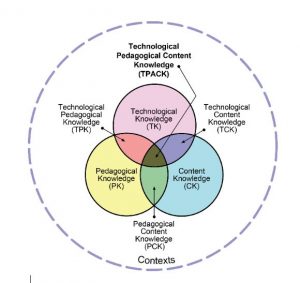The TPACK Model: A Guide for Technology Integration
Developed by Punya Mishra and Matthew Koehler (Koehler, 2012), the TPACK model, also known as the Technological Pedagogical Content Knowledge model, is an educational framework used to comprehend and describe the knowledge and skills instructors need to integrate technology effectively into their teaching. It can serve as a guide as teachers consider how proficient they are at integrating technology into their teaching in meaningful ways. TPACK “represents a full understanding of how to teach with technology” (PowerSchool, 2022, para. 3).
The TPACK model consists of three primary types of knowledge that teachers ideally should possess:
- Technological Knowledge (TK): Technological knowledge (TK) is a teacher’s understanding of available technologies to them and how best to use them. This area is essentially “knowledge of, and ability to use, various technologies, technological tools, and associated resources” (PowerSchool, 2022, para. 8).
- Pedagogical Knowledge (PK): Pedagogical knowledge (PK) can be seen as “knowledge of the practices, processes, and methods regarding teaching and learning” (PowerSchool, 2022, para. 7). This is what allows an instructor to design and deliver practical lessons, manage their classrooms, assess their students’ learning, and adapt their instruction to meet the needs of learners.
- Content Knowledge (CK): Content knowledge (CK) is to a professor’s knowledge of their field of expertise. It includes the “knowledge of concepts, theories, evidence, and organizational frameworks within a particular subject matter” (PowerSchool, 2022, para. 6)
Additionally, the TPACK model recognizes that effective technology integration in education requires an intersection or merger of these knowledge domains. These are the overlap areas on the Venn diagram below.
- Technological Pedagogical Knowledge (TPK): TPK is the knowledge of how to use technology in the context of teaching and learning. One can see this as “understanding how to use your digital tools as a vehicle to the learning outcomes and experiences you want” (PowerSchool, 2022, para. 21).
- Technological Content Knowledge (TCK): This represents the knowledge of how technology can be used to teach specific content. This is “knowing how the digital tools available to you can enhance or transform the content, how it’s delivered to students, and how your students can interact with it” (PowerSchool, 2022, para. 21)
- Pedagogical Content Knowledge (PCK): PCK represents the knowledge of how to teach specific subject matter effectively. It involves “understanding the best practices for teaching specific content to your specific students” (PowerSchool, 2022, para. 21).
The TPACK model emphasizes that effective technology integration in education requires the synergy of all these knowledge domains. Teachers need to balance their technological, pedagogical, and content knowledge to make informed decisions about when and how to use technology in their teaching to enhance student learning. “Technological Pedagogical Content Knowledge (TPACK) attempts to identify the nature of knowledge required by teachers for technology integration in their teaching while addressing the complex, multifaceted and situated nature of teacher knowledge” (Koehler, 2012, para. 1).
THE TPACK MODEL

Image reproduced by permission of the publisher, © 2012 by tpack.org
References
Koehler, M. (2012, September 24). TPACK explained. TPACK.org. http://www.tpack.org/
PowerSchool. (2022, April 20). The TPACK model explained (with classroom examples). https://www.powerschool.com/blog/the-tpack-framework-explained-with-classroom-examples/
